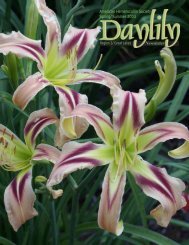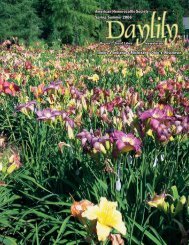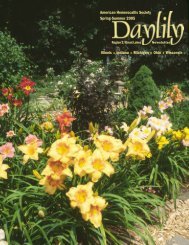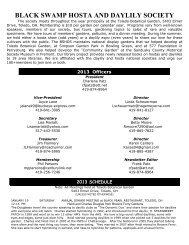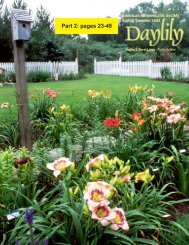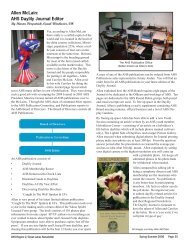Part 1, Pages 1-23 - AHS Region 2
Part 1, Pages 1-23 - AHS Region 2
Part 1, Pages 1-23 - AHS Region 2
Create successful ePaper yourself
Turn your PDF publications into a flip-book with our unique Google optimized e-Paper software.
STEVE MOLDOVAN’S QUEST FOR<br />
A PIECE OF THE SKY<br />
By Sharon Fitzpatrick, Canal Winchester, Ohio.<br />
or more than 50 years Steve Moldovan has been blessed, or<br />
some would say cursed, with a driving passion to create<br />
Fquality, clear-colored daylilies that would thrive in various growing<br />
climates. Steve learned the art of hybridizing by walking side by<br />
side with daylily pioneers whose works many of us have only read<br />
about. Over the years Steve has never taken credit for hybridizing<br />
alone; instead, he states that he owes his success to the creations of<br />
other hybridizers before him. Dedicated to his passion through hard<br />
work, meticulous record keeping of plant parentages, and the unrelenting<br />
search for the elusive blue daylily, he has only orchestrated<br />
the gene pool created by others in a way they never thought of doing.<br />
The best place to start this success story is at the beginning.<br />
The Early Years<br />
Steve Moldovan is a professional ornamental horticulturist whose<br />
gardening roots stem from an onion patch located on a fertile ridge<br />
of Lake Erie. Purchased in 1959, the property is now known as<br />
Moldovan’s Gardens. Gardening has always been a driving force in<br />
Steve’s life. As a teenager he preferred to grow gaudy iris and peonies<br />
because he liked to see a lot of color. He had read about a<br />
breeder of iris in the Chicago area by the name of Orville Fay. Steve’s<br />
brother was a model airplane buff, and their father would take him<br />
all over the country to fly his planes. When Steve found out they<br />
were going to Chicago for a model airplane event, he begged to go<br />
along so he could meet Mr. Fay and witness first hand the advancements<br />
Mr. Fay was making in iris. By mistake, Steve discovered<br />
daylilies.<br />
When Steve arrived at Orville Fay’s garden, there was nothing<br />
left of the iris but foliage. The Fay garden was, however, full of<br />
daylilies in bloom. The young Steve was so fascinated by daylilies<br />
that, during high school years, he returned each summer to Orville<br />
Fay’s garden to help care for the plants and learn the ins and outs of<br />
hybridizing. Steve knew daylilies were wonderful plants because<br />
they took nature’s abuse without skipping a beat, were disease resistant,<br />
resistant to pests, and did not require treatment with poisonous<br />
chemicals to keep away the borer that so often hit iris.<br />
Back in the late fifties, the hottest daylily was a seedling Orville<br />
Fay referred to as SATIN GLASS, which was registered by that<br />
name in 1960. Steve was in Fay’s garden the day SATIN GLASS<br />
(Fay-Hardy 1960) first bloomed. Never had there been such a widepetaled<br />
daylily. The flower was not the usual orange color but was,<br />
instead, almost white. It was SATIN GLASS that hooked Steve on<br />
the daylily. When Steve saw Fay’s wide-petaled seedling FIRST<br />
FORMAL (registered in 1960) bloom, which was narrow by today’s<br />
standards, he thought he had died and gone to heaven because, by<br />
daylily standards of that time, the flower color was considered to<br />
be pink. Using SATIN GLASS, FIRST FORMAL, its sister sibling<br />
LAVENDER PARADE (Fay-Moldovan 1960), and Dr. Ezra<br />
Kraus’s ATLAS, Steve saw his first seedlings bloom in 1958. From<br />
this group of seedlings in 1960 he registered the cultivar BURIED<br />
TREASURE (ATLAS X SATIN GLASS), the first of a long line of<br />
daylilies, with the American Hemerocallis Society.<br />
BURIED TREASURE grew and multiplied like a weed. By its<br />
second year Steve had 150 plants. It did not take him long to learn<br />
that black daylily seed was like gold to a hybridizer. An imaginative<br />
man on a mission, Steve began the so far unknown practice of<br />
incorporating evergreen daylilies from Florida and Louisiana hybridizers<br />
with hard dormant, northern bred cultivars.<br />
Steve finished his formal education at The Ohio State University,<br />
and his hybridizing program was just beginning when he was<br />
called up to serve in the US Army Reserve. Not wanting to leave<br />
the garden but being a firm believer in “everything happens for a<br />
reason,” a reluctant Steve was assigned to active duty. By chance,<br />
Steve was stationed at a base in Louisiana located near the garden<br />
of premier daylily hybridizer Edna Spalding. In his free time he<br />
would drive or take a bus to visit Edna and her flowers. On one of<br />
those visits Edna’s BLUE JAY (1961) was blooming. Steve thought<br />
BLUE JAY was the most wondrously colored daylily he had ever<br />
seen. Full of daylily dreams, a young and eager Steve was sure that<br />
by using BLUE JAY in his hybridizing program he would have a<br />
sky blue daylily before anyone else knew what was happening. When<br />
Steve went home to Avon, BLUE JAY went with him.<br />
Unfortunately, Steve was to find out after breeding with it that<br />
the plant was a tender evergreen, and it died the first winter. All<br />
SATIN GLASS (Fay-Hardy 1960) Slide: Howard Hite<br />
Page 4 Spring-Summer 2004<br />
Steve Moldovan’s 1961 BURIED TREASURE (Slide: Howard Hite)<br />
<strong>AHS</strong> <strong>Region</strong> 2/Great Lakes Newsletter



